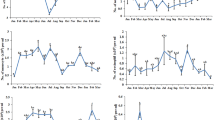Abstract
Lymphocyte proliferation is a prerequisite for most aspects of the mammalian acquired immune response. Splenic lymphocytes from golden-mantled ground squirrels collected at different phases of hibernation were stimulated in vitro with several mitogens to measure proliferative ability at several temperatures. No differences were seen in lymphocyte proliferation at any of the temperatures tested between animals at different stages of hibernation. No proliferation was detected at 5°C. T cell mitogens induced significantly higher proliferation at 37°C than at 27°C in lymphocytes from both summer and hibenrating animals. A B cell mitogen induced similar proliferation at both 27° and 37°C in cells from summer and hibernating animals. Lymphoocyte proliferation appears to be highly temperature-dependent in both summer and hibernating animals. Therefore, interbout arousals are essential for the production of a successful acquired immune response during hibernation.
Access this chapter
Tax calculation will be finalised at checkout
Purchases are for personal use only
Preview
Unable to display preview. Download preview PDF.
Similar content being viewed by others
References
Andjus AK, Matic O, Petrovic V, Rajevski V (1964) Influence of hiberntion and intermittent hypothermia on the formation of immune hemaglutinins in the ground squirrel. Annals Acad Sci Fenn 71(2):26–36
Beaudoin RL, Davis DE, Murrell KD (1969) Antibodies to larval Taenia crassiceps in hibernating woodchucks, Marmota monax. Exp Parasitol 24:42–46
Boyer BB, Barnes BM (1999) Molecular and metabolic aspects of mammalian hibernation. BioScience 49(9):713–724
Buttke TM, Wang Yang MC, Van Cleave S, Miller NW, Clem LW (1991) Correlation between low-temperature immunosuppression and the absence of unsaturated fatty acid synthesis in murine T cells. Comp Biochem Physiol 100B(2):269–276
Cahill JE, Lewert RM, Jaroslow BN (1967) Effect of hibernation on course of infection and immune response in Citellus tridecemlineatus infected with Nippostrongylus brasiliensis. J Parasit 53(1):110–115
Carr AH, Amborski RL, Culley jr. DD, Amborski GF (1976) Aerobic bacteria in the intestinal tracts of bullfrogs (Rana catesbeiana) maintained at low temperatures. Herpetologica 32:239–244
Demas GE, Chefer V, Talan MI, Nelson RJ (1997) Metabolic costs of mounting and antigenstimulated immune response in adult and aged C57BL/6J mice. Am J Physiol 273(42):R1631-R1637
Frank CL, Dierenfeld ES, Storey KB (1998) The relationship between lipid peroxidation, hibernation, and food selection in mammals. Amer Zool 3 8: 341–349
Frerichs KU, Smith CB, Brenner M, DeGracia DJ, Krause GS, Marrone L, Dever TE, Hallenbeck JM (1998) Suppression of protein synthesis in brain during hibernation involves ihnhibition of protein initiation and elongation. Proc Natl Acad Sci USA 95:14511–14516
Geiser F, Ruf T (1995) Hibernation versus daily torpor in mammals and birds: physiological variables and classification of torpor patterns. Physiol Zool 68(6):935–966
Heller HC, Grahn DA, Trachsel L, Larkin JE (1993) What is a bout of hibernation? In: Carey C, Florant GL, Wunder BA, Horwitz B, (eds) Life in the Cold. Westview Press, Boulder, San Francisco, Oxford, pp 253–264
Jaroslow BN (1968) Development of the secondary hemolysin response in hibernating ground squirrels (Citellus tridecemlineatus). Proc Natl Acad Sci USA 61(1):69–76
Karmanova IG (1995) The physiology and genesis of hibernation. J Evol Biochem Physiol 31(2):116–122
Kolaeva SG, Kramarova LI, Ilyasova EN, Ilyasov FE (1980) The kinetics and metabolism of the cells of hibernating animals during hibernation. Int Rev Cytol 66:147–170
Larsen B (1971) Antibody formation in hedgehogs-II. Hibernating animals. Comp Biochem Physiol 38A:571–580
Lyman CP (1958) Metabolic adaptations of hibernators. Federation Proceedings 17(4):1057–1060
McKeever S (1964) The biology of the golden-mantled ground squirrel, Citellus lateralis. Ecol Monogr 34(4):383–401
McKenna JM, Musacchia XJ (1968) Antibody formation in hibernating ground squirrels (Citellus tridecemlineatus). Proc Soc Exp Biol Med 129:720–724
Nedergaard J, Cannon B (1990) Mammalian hibernation. Phil Trans R Soc Lond B 326:669–686
Rapp HJ, Borsos T (1970) Molecular Basis of Complement Action. Appleton-Century-Crofts, New York
Sherman PW, Morton ML (1984) Demography of Belding’s ground squirrels. Ecology 65(5):1617–1628
Shivatcheva TM (1989) Circannual variations of the immune system of hibernators. In: Malan A, Canguilhem BC, (eds) Living in the Cold II. Colloque INSERM/John Libbey Eurotext Ltd. pp 87–95
Suomalainen P, Oja H (1967) Studies on the physiology of the hibernating hedgehog. 5. The mitotic activity in relation to seasonal and hibernation cycles. Commentationes Biologicae 30(4):1–6
Wang LCH (1989), Ecological, physiological, and biochemical aspects of torpor in mammals and birds In: Wang LCH, (ed) Advances in Comparative and Environmental Physiology. Springer-Verlag, Berlin, Heidelberg pp 361–401
Wang-Yang MC, Buttke TM, Miller NW, Clem LW (1990) Temperature-mediated processes in immunity: differential effects of low temperature on mouse T helper cell responses. Cell Immunol 126:354–366
Wang-Yang MC, Cuchens MA, Buttke TM (1986) Kinetics of membrane immunoglobulin capping on murine B lymphocytes. Effects of phospholipid fatty acid replacement. J Biol Chem 261(7):3320–3324
Wooten RM, Clem LW, Bly JE (1993) The effects of temperature and oleic acid on muring memory and virgin T cell activation: interleukin-2 secretion and interleukin-2 receptor expression. Cell Immunol 152:35–48
Wooten RM, Cuchens MA, Causey AL, Clem LW, Bly JE (1997) Effects of oleic acid on murine CD4+ T cell death and anti-CD3 or superantigen induced proliferation at low temperature. Develop Comp Immunol 21(4):375–384
Author information
Authors and Affiliations
Editor information
Editors and Affiliations
Rights and permissions
Copyright information
© 2000 Springer-Verlag Berlin Heidelberg
About this paper
Cite this paper
Maniero, G.D. (2000). The Influence of Temperature and Season on Mitogen-Induced Proliferation of Ground Squirrel Lymphocytes. In: Heldmaier, G., Klingenspor, M. (eds) Life in the Cold. Springer, Berlin, Heidelberg. https://doi.org/10.1007/978-3-662-04162-8_51
Download citation
DOI: https://doi.org/10.1007/978-3-662-04162-8_51
Publisher Name: Springer, Berlin, Heidelberg
Print ISBN: 978-3-642-08682-3
Online ISBN: 978-3-662-04162-8
eBook Packages: Springer Book Archive




